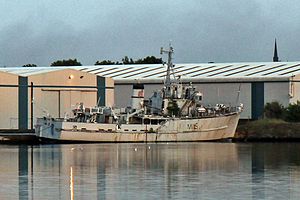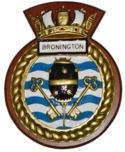HMS Bronington (M1115)
 HMS Bronington laid up at Birkenhead in June 2015
| |
| History | |
|---|---|
| Name | HMS Bronington |
| Namesake | Bronington, Wales |
| Builder | Cook, Welton & Gemmell, Beverley |
| Laid down | 30 May 1951 |
| Launched | 19 March 1953 |
| Commissioned | 4 June 1954 |
| Decommissioned | 30 June 1988 |
| Identification | Pennant number: M1115 |
| Fate | Sunk at her moorings in March 2016. Still partially sunk. |
| Badge |  |
| General characteristics | |
| Class and type | Ton-class minesweeper |
| Displacement | 440 long tons (450 t) |
| Length | 153 ft (46.6 m) |
| Beam | 28.9 ft (8.8 m) |
| Draught | 8.2 ft (2.5 m) |
| Propulsion | 2 × Paxman Deltic 18A-7A diesel engines at 3,000 bhp (2,200 kW) |
| Speed | Cruise 13 knots (24 km/h) on one engine. Max 16 knots (30 km/h) on both |
| Range | 2,500 nautical miles (4,600 km) at 12 knots (22 km/h) |
| Complement | 32 |
| Armament | 1 x Bofors 40 mm gun |
HMS Bronington is a former Ton-class minesweeper of the Royal Navy, named HMS Humber between 1954 and 1958. This mahogany-hulled minesweeper was one of the last of the wooden-hulled naval vessels. Decommissioned in 1988, she was subsequently a museum ship, but sank at Birkenhead in 2016.
History
[edit]Bronington was laid down on 30 May 1951 by Cook, Welton & Gemmell at Beverley, Yorkshire. Built on the River Hull, she was launched on 19 March 1953 and was commissioned as HMS Humber on 4 June 1954. Humber spent four years in the Royal Naval Volunteer Reserve, serving as part of the 101st Minesweeping Squadron.[1][2]
Reverting to her original name in 1958, the vessel was converted into a minehunter at Rosyth Dockyard between 1963 and 1965, and was commissioned to, initially, the 5th Minesweeper Squadron, and then the 1st Mine Countermeasures Squadron on 5 January 1967.[3]
Prince Charles commanded the vessel between 9 February and 15 December 1976.[4] Subsequently, under the command of his successor, Lieutenant A B Gough, Bronnington ran aground in the River Avon while departing from Bristol.[5]
During the late 1980s, the vessel saw service in the Mediterranean Sea as part of 2nd Mine Counter Measures Squadron, with NATO as part of the Standing Naval Force Channel and also as a fishery protection vessel.
After being decommissioned from service, the ship was purchased in January 1989 by the Bronington Trust, a registered charity whose patron is the King.[5] For some time, the ship was berthed in the Manchester Ship Canal at Trafford Park and was open to visitors for ten years. On 11 July 2002, she became part of the collection of the Warship Preservation Trust and was moored at Birkenhead, Merseyside.[1] After the closure of the Warship Preservation Trust, she remained in storage, formerly alongside the Rothesay-class frigate HMS Plymouth at Vittoria Dock, and latterly in the West Float of Birkenhead Docks.
On 17 March 2016, Bronington sank at her moorings.[6][7][8][9]
Preservation
[edit]In December 2021 the HMS Bronington Preservation Trust was formed with the aim of raising and preserving the vessel.[10]
As of 2023, the ship is still partially submerged. The preservation trust commissioned a dive survey in June 2022 to establish the state of the vessel.[11] The survey revealed the vessel to be in good condition, with only two minor holes in the hull. Subject to fund raising, the trust hopes to move the vessel to a dry dock at Cammell Laird where she will be restored, either for sailing or for use as a static museum exhibit.[12] In June 2023, the National Museum of the Royal Navy said that there are potential locations in Portsmouth Historic Dockyard, which could be considered if the restoration effort is successful.[13]
References
[edit]- ^ a b Colledge, J. J.; Warlow, Ben (2006). Ships of the Royal Navy: A Complete Record of All Fighting Ships of the Royal Navy From the 15th Century to the Present. London: Chatham Publishing. p. 56. ISBN 1612000274.
- ^ "About the ship". HMS Bronington. 27 April 2016. Retrieved 6 August 2022.
- ^ Brown, Paul (2010). Historic Ships: The Survivors. Stroud: Amberley Publishing. ISBN 978-1-84868-994-7.
- ^ Brandreth, Gyles (2007). Charles and Camilla: Portrait of a Love Affair. UK: Random House. p. 170. ISBN 978-0-09-949087-6.
- ^ a b Brown, Michèle (1980). Prince Charles. London: Artus. p. 125. ISBN 0-51754-019-3.
- ^ Graham, Barry (19 March 2016). "HMS BRONINGTON M1115". Shipspotting. Retrieved 21 March 2016.
- ^ "News in brief: sad demise of ship the Prince once captained". The Times. 26 April 2016. Retrieved 8 September 2022.
- ^ Naylor, Mary (25 April 2016). "Pictures show sunken state of Prince Charles' former Royal Navy ship". Liverpool Echo. Retrieved 8 September 2022.
- ^ End for Bronington Ships Monthly August 2016 page 18
- ^ "Timeline". HMSBronington.org. Retrieved 6 August 2022.
- ^ "Dive Survey Friday 24th June 2022 | HMS Bronington". HMS Bronington Preservation Trust. 25 June 2022. Retrieved 7 August 2022.
- ^ Deeks, Steve (18 May 2022). "Former crew on submerged warship fondly remember service amid restoration efforts". www.portsmouth.co.uk. Retrieved 7 August 2022.
- ^ Deeks, Steve (5 June 2023). "Royal Navy's HMS Bronington: 'Last of wooden walls' set for romantic return to Portsmouth after 35 years". The News. Portsmouth. Retrieved 22 July 2023.
